CBSE Sample Papers for Class 12 Physics Set-6
Class 12thCBSE Sample Papers for Class 12 Physics Set-6
CBSE Sample Papers for Class 12 Physics Set-6
Time : 3 hrs
Max. Marks : 70
Instructions
1. There are 33 questions in all. All questions are
compulsory.
2. This question paper has five sections : Section A, Section B,
Section C, Section D and Section E.
3. All the sections are compulsory.
4.
Section A contains sixteen questions, twelve MCQ and four Assertion Reasoning
based of 1 mark each, Section B contains five questions of two marks each,
Section C contains seven questions of three marks each, Section D contains two
case study based questions of four marks each and Section E contains three long
answer questions of five marks each.
5. There is no overall choice. However,
an internal choice has been provided in one question in Section B, one question
in Section C, one question in each CBQ in Section D and all three questions in
Section E. You have to attempt only one of the choices in such questions.
6.
Use of calculators is not allowed.
7. You may use the following values of
physical constants where ever necessary.
(i) c = 3 × 108 m/s
(ii) me = 9.1 × 10-31 kg
(iii) e = 1.6 ×
10-19 C
(iv) µ0 = 4π × 10-7 TmA×
10-1
(v) h = 6.63 × 10-34 Js
(vi) ε0 =
8.854 × 10-112 C2N-1m-2
(vii)
Avogadro’s number = 6.023 × 1023 per gram mole
Section A
Question 1.
A uniform magnetic field parallel to the plane of paper exists
in space, initially directed from left to right. When a bar of soft iron is
placed in the field parallelly, the lines of force passing through it will
appears as in [1]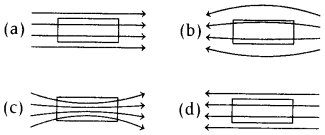
Answer:
Since soft iron has high relative permeability, so maximum field lines will pass through it when it is placed in a uniform magnetic field. Hence, Fig. (c) correctly shown the given situation.
Question 2.
An electromagnetic wave of frequency v = 3.0 MHz passes from
vacuum into a dielectric medium with permittivity ε = 4.0F/m, then [1]
(a)
wavelength is doubled and the frequency remains unchanged
(b) wavelength is
halved and frequency becomes half
(c) wavelength is halved and frequency
remains unchanged
(d) wavelength and frequency both remain unchanged
Answer:
(c) wavelength is halved and frequency remains unchanged
We know that, in vacuum, ε0 = 1
In medium, ε = 4 F/m
So.
refractive index, n = \(\sqrt{\varepsilon / \varepsilon_0}\) = \(\sqrt{4 / 1}\)
= 2
Wavelength, λ’ = \(\frac{\lambda}{n}\) = \(\frac{\lambda}{2}\)
and
wave velocity, v = \(\frac{c}{n}\) = \(\frac{c}{2}\) (∵ n = \(\frac{c}{v}\))
Hence, it is clear that wavelength and velocity will become half but frequency
remains unchanged when the wave is passing through any medium.
Question 3.
Pure silicon at 300 K has equal electron (ne) and
hole (nh) concentration of 1.5 × 1016m-3.
Doping by indium increases nh to 4.5 × 1022m-3.
The ne in dpped silicon (in m-3) is [1]
(a) 9 ×
105
(b) 5 × 109
(c) 2.25 × 1011
(d) 3
× 1019
Answer:
(b) 5 × 109
In an extrinsic semiconductor, nenh =
nnin2
⇒ ne × 4.5 × 1022 = (1.5 ×
1016)2
⇒ ne = \(\frac{2.25 \times
10^{32}}{4.5 \times 10^{22}}\)
⇒ ne = 5 × 10=> n9
m-3
Question 4.
If a medium of relative permeability μr had been
present instead of air, the mutual inductance would be [1]
(a) M = \(\mu_r,
\mu_0 n_1 n_2 \pi r_1 l\)
(b) M = \(\mu_0 n_1 n_2 \pi r_1^2 l\)
(c) M =
\(\mu_r n_1 n_2 \pi r_1^2 l\)
(d) M = \(\mu_r, \mu_0 n_1 n_2 \pi r_1^2
l\)
Answer:
(d) M = \(\mu_r, \mu_0 n_1 n_2 \pi r_1^2 l\)
Air as the medium within the solenoids. Instead, if a medium of relative
permeability μr had been present, the mutual inductance would be
M
= \(\mu_r, \mu_0 n_1 n_2 \pi r_1^2 l\).
It is also important to know that the
mutual inductance of pair of coils, solenoids etc., depends on their separation
as well as their relative orientation.
Question 5.
Which of the following statement is correct property for
equipotential §urfaces in uniform electric field? [1]
(a) Two equipotential
surfaces intersect each other at acute angles.
(b) Electric lines of force
are perpendicular to equipotential surface.
(c) Work done in moving a charge
on equipotential surface is always negative.
(d) Equipotential surface is
always spherical in shape.
Answer:
(b) Electric lines of force are
perpendicular to equipotential surface.
The statement given in option (b) is correct but rest are incorrect and these
can be corrected as follows.
Two equipotential surfaces can never intersect
each other. Work done in moving a charge on equipotential surface is always zero
because electric field lines are always perpendicular to the surface.
The
shape of equipotential surface depends on the source of electric field. For a
point charge, it is spherical in shape. For a line charge, it is cylindrical in
shape.
Question 6.
Taking the Bohr radius as a0 = 53 pm, the radius of
Li++ ion in its ground state, on the basis of Bohr’s model, will be
about [1]
(a) 53 pm
(b) 27 pm
(c) 18 pm
(d) 13 pm
Answer:
(c)
18 pm
The atomic number of lithium is 3. Therefore, the radius of Li++ ion in its ground state, on the basis of Bohr’s model, will be about \(\frac{1}{3}\) times to that of Bohr radius. Therefore, the radius of lithium ion is near \(\frac{53 i}{3}\) ≈ 18 pm.
Question 7.
When a 220 V AC is applied to a capacitor C, then [1]
(a)
The phase of voltage and current is same.
(b) Between the plates of
capacitor, maximum voltage is 220 V.
(c) Average power delivered to the
capacitor per cycle is zero.
(d) Charge on the plate is not in phase with the
applied voltage
Answer:
(c) Average power delivered to the capacitor per
cycle is zero.
When AC voltage of 220 V is applied to a capacitor C, the charge on the
plates is in phase with the applied voltage. As, the circuit is purely
capacitive, so the current leads the voltage by an angle of 90°.
∴ Power
dissipation per cycle in capacitive circuit,
P = Vrms
Irms cos 90° = 0
Question 8.
Which of the following is true for rays coming from infinity?
[1]
(a) Two images are formed at two different points
(b) Continuous image
is formed between focal points of upper and lower lens
(c) One image is
formed by the lens
(d) None of the above
Answer:
(a) Two images are
formed at two different points
Since, lens is made of two layers of different refractive indices, for a given wavelength of light, it will have two different focal lengths or will have two images at two different points as \(\frac{1}{f}\) ∝ (μ – 1) (from lens Maker’s formula).
Question 9.
A point charge +10 μC is at a distance 5 cm directly above the
centre of a square of side 10 cm, as shown in figure. What is the magnitude of
the electric flux through the square? [1]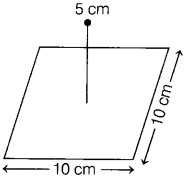
(a) Zero
(b) 1.8 × 102 N-m2C
(c)
1.8 × 104 N-m2C-1
(d) 1.8 × 105
N-m2C-1
Answer:
(d) 1.8 × 105
N-m2C-1
A point charge +10 μC is at a distance 5 cm above the centre of a square of
side 10 cm is shown below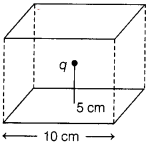
Given, q = +10 μC = 10 × 10-6 C
According to
Gauss’s theorem, the total flux
enclosed, ϕ = \(\frac{q}{\varepsilon_0}\)
…..(i)
The flux enclosed by one face of square is (1/6) of total flux
(because the cube has six square shaped faces).
The flux linked with each
face,
ϕ’ = \(\frac{\phi}{6}\) = \(\frac{1}{6}\) ⋅ \(\frac{q}{\varepsilon_0}\)
[from Eq.(i)]
ϕ’ = \(\frac{1}{6}\) × \(\frac{10 \times 10^{-6}}{8.854 \times
10^{-12}}\)
= 1.88 × 105 N-m2C-1
Thus,
the flux linked with the square is
1.8 × 105
N-m2C-1.
Question 10.
The variation of current in a coil with respect to time is
shown below. If the resistance of the coil is 200 Q, then the change in magnetic
flux through the coil is [1]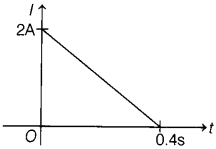
(a) 600 Wb
(b) 800 Wb
(c) 400 Wb
(d) 1000 Wb
Answer:
(b) 800 Wb
Given, R = 200 Ω
By Faraday’s law
Induced emf, e = \(\frac{d \phi}{d
t}\)
Induced current, I = \(\frac{e}{R}\) = \(\frac{1}{R}\) ⋅ \(\frac{d
\phi}{d t}\)
⇒ \(\int d \phi\) = R \(\int l d t\) = R × Area of l-t graph
∴ Change in flux, ∆ϕ = 200 × \(\frac{1}{2}\) × 20 × 0.4
= 800 Wb
Question 11.
The maximum kinetic energy of emitted electron decreases as
[1]
(a) the work function of metal increases
(b) the work function of
metal decreases
(c) the frequency of incident photon increases
(d) the
wavelength of incident photon decreases
Answer:
(a) the work function of
metal increases
By Einstein’s photoelectric equation
KEmax = hv – ϕ0
= \(\frac{h c}{\lambda}\) – ϕ0
∴ KEmax ∝ v or
\(\frac{1}{\lambda}\)
Also, as the work function of metal increases, the
maximum kinetic energy of photoelectrons decreases.
Question 12.
The electric current in a wire AB is shown below. The
direction of induced current in the loop is [1]
(a) clockwise with increasing current in AB
(b) clockwise
with decreasing current in AB
(c) anti-clockwise with decreasing current in
AB
(d) clockwise with constant current in AB
Answer:
(b) clockwise with
decreasing current in AB
As, the current in the wire AB decreases. So, the magnetic flux linked with the coil decreases into the plane of paper. By Lenz’s law, induced current in the coil is such that it increases the linked flux due to the wire. Flence, the direction of current in the coil is clockwise.
For questions 13 to 16 two statements are given-one labelled
Assertion (A)
and other labelled Reason (R).
Select the correct answer to these questions
from the options as given below.
(a) If both A and R are true and R is the
correct explanation of A.
(b) If both A and R are true but R is not the
correct explanation of A.
(c) If A is true but R is false.
(d) If both A
and R are false.
Question 13.
Assertion (A) The magnetic field produced by a current
carrying solenoid is independent of its length and cross-sectional area.
Reason (R) The magnetic field inside the solenoid is uniform. [1]
Answer:
(b) If both A and R are true but R is not the correct explanation of A.
The magnetic field due to solenoid having n number of turns/metre and
carrying current l is
B = μ0nl.
It is obvious that, magnetic
field is independent of length and cross-sectional area.
Also, magnetic field
is uniform inside the solenoid. Therefore, A and R are true but R is not the
correct explanation of A.
Question 14.
Assertion (A) The self-inductance of a coil is increased by a
factor of four, if the number of turns of the coil is doubled.
Reason (R) The
self-inductance of a coil is proportional to the square of number of turns of
the coil. [1]
Answer:
(a) If both A and R are true and R is the correct
explanation of A.
The self-inductance of a coil is L ∝ N2
If number of turns (N)
becomes doubled, then
\(\frac{L_2}{L_1}\) = (\(\frac{2 N}{N}\))2 =
4
∴ L2 = 4 L1
Question 15.
Assertion (A) The energy of electron in first excited state
of hydrogen atom is – 3.4 eV.
Reason (R) When electrons jumps from any higher
state to first excited state in hydrogen atom, then balmer series are obtained.
[1]
Answer:
(b) If both A and R are true but R is not the correct
explanation of A.
The energy of electron in nth orbit of hydrogen atom,
En =
\(-\frac{13.6}{n^2}\) eV
∴ Energy in first excited state (n = 2),
E2 = \(-\frac{13.6}{(2)^2}\) = -3.4 eV
Balmer series are obtained
when electron jumps from other higher state to first excited state.
Question 16.
Assertion (A) The graph of de-Broglie wavelength versus
stopping potential is a rectangular hyperbola.
Reason (R) de-Broglie
wavelength of a particle is inversely proportional to square root of the
stopping potential. [1]
Answer:
(a) If both A and R are true and R is the
correct explanation of A.
The de-Broglie wavelength of a particle is given by
λ = \(\frac{h}{\sqrt{2
m q V}}\) ⇒ λ ∝ \(\frac{1}{\sqrt{v}}\)
Flence, the graph of X versus V is a
rectangular hyperbola.
Section B
Question 17.
Diameter of a plano-convex lens is 6 cm and its thickness is
4 mm. What is the focal length of the lens, if refractive index of the glass is
1.5? [2]
Or
A screen is placed 90 cm from an object. The image is obtained
on the screen by a convex lens at two different locations separated by 20 cm.
Determine the focal length of lens. [2]
Answer:
According to the lens
Maker formula,
\(\frac{1}{f}\) = (μ – 1) (\(\frac{1}{R_1}\) –
\(\frac{1}{R_2}\))
For plano-convex lens, R1 = R
and
R2 = ∞, μ = 1.5 (given)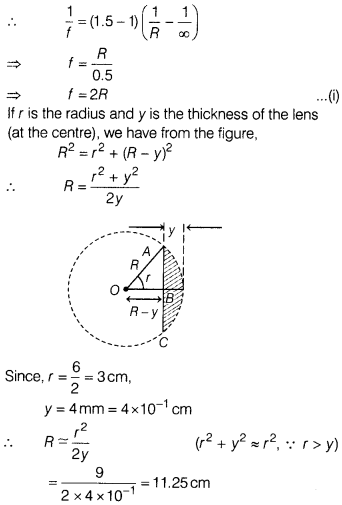
Putting the value of R in Eq. (i), we get
f = 2 × R = 2 ×
11.25
∴ f = 22.5 cm
Or
The two situations can be drawn as below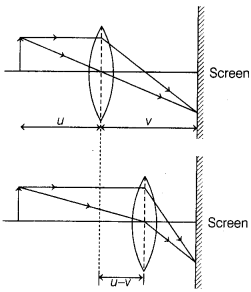
From question, it is given that
u + v = 90 ….(i)
and u
– v =20 …(ii)
Solving Eqs. (i) and (ii), we get
u = 55 cm and v = 35
cm
Using sign convention and lens formula, the focal length of lens,
\(\frac{1}{f}\) = \(\frac{1}{v}\) – \(\frac{1}{u}\)
⇒ \(\frac{1}{f}\) =
\(\frac{1}{35}\) – \(\frac{1}{(-55)}\)
= \(\frac{90}{35 \times 55}\)
⇒ f =
21.39 cm
Question 18.
Two conducting wires X and Y are shown below,
The number density of electrons in Y is three times that in
X. These are joined in series across a battery. Find the ratio of drift speed of
electron in two wires. [2]
Answer:
Given, diameter of X = \(\frac{1}{2}\)
× diameter of Y
Area of cross-section of X, AX = π
(\(\frac{d_X}{2}\))2
Area of cross-section of Y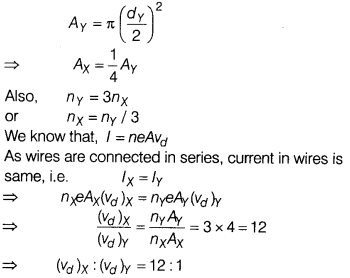
Question 19.
Work function of a certain metal is 2 eV. When light of
frequency 5 × 1015 Hz is incident on the metal surface, emission of
electrons take place. Find
(i) maximum kinetic energy of emitted electrons
and [1]
(ii) stopping potential. [1]
Answer:
ϕ0 = 2 eV = 2 ×
1.6 × 10-19 J
ν = 5 × 1015
(i) Maximum kinetic energy of emitted electrons
EK = hν –
ϕ0
= 6.63 × 10-34 × 5 × 1015 – 2 × 1.6 ×
10-19
= 33.15 × 10-19 – 3.2 × 10-19
=
29.95 × 10-19 J
= \(\frac{29.95 \times 10^{-19}}{1.6 \times
10^{-19}} \mathrm{eV}\)
EK = 18.7 eV
(ii) Stopping potential V0 is given by
EK = e
V0
V0 = \(\frac{E_K}{e}\) = \(\frac{18.7
\mathrm{eV}}{e}\) = 18.7 V
Question 20.
The momentum of photon of electromagnetic radiation is 3.3 ×
10-29 kg-ms-1.
Find out the frequency and wavelength of
the wave associated with it. [2]
Answer:
As given,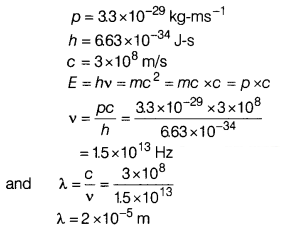
Question 21.
Write two characteristic features to distinguish between
n-type and p-type semiconductor. [2]
Answer:
| n-type semiconductor | p-type semiconductor |
| It has donor energy levels that are very close to the conduction band. | It has acceptor energy levels that are very close to valence band. |
| The majority of charge carriers move from low potential to high potential. | The majority of charge carrier move from high potential to low potential. |
Section C
Question 22.
Explain in brief, why Rutherford’s model cannot account for
the stability of an atom? [3]
Answer:
Electrons revolving around the
nucleus have centripetal acceleration. According to classical electromagnetic
theory, an accelerated electron must radiate energy in the form of
electromagnetic waves. Due to this continuous loss of energy of electron, the
radii of their orbits should be continuously decreasing and ultimately the
electron should fall into the nucleus.
Question 23.
A cube of side a has a charge q at each of its vertices.
Determine the potential due to this charge array at the centre of the cube.
[3]
Answer:
Consider a cube of side a and its centre be O. The charge q is
placed at each of its vertices.
Side of the cube = a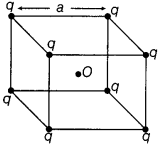
Length of the main diagonal of the cube
=
\(\sqrt{a^2+a^2+a^2}\) = √3 a
Distance of centre 0 from each of the
vertices,
r = \(\frac{a \sqrt{3}}{2}\) ………(i)
Potential at point 0 due to
one charqe,
V = \(\frac{1}{4 \pi \varepsilon_0}\) . \(\frac{q}{r}\)
Potential at point O due to all charges placed at the vertices of the cube,
V’ = 8 V = \(\frac{8 \times 1 \times q}{4 \pi \varepsilon_0 r}\)
= \(\frac{8
q \times 2}{4 \pi \varepsilon_0 \cdot a \sqrt{3}}\) [from Eq. (i)]
=
\(\frac{4 q}{\sqrt{3} \pi \varepsilon_0 a}\)
Question 24.
(i) Mention two characteristic properties of isotopes.
[2]
(ii) Obtain approximately the ratio of the nuclear radii of the gold
isotope \({ }_{79}^{197} \mathrm{Au}\) and the silver isotope \({ }_{47}^{107}
\mathrm{Ag}\). [1]
Answer:
(i) (a) Isotopes have same number of
protons.
(b) They have different number of neutrons.
(ii) Radius of nuclei, R = R0A1/3
where, A is the
mass number of nucleus and R0 is an empirical constant.
∴ R ∝
A1/3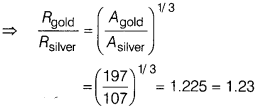
Question 25.
Write the relation between emf and potential difference for a
cell. What are their respective units? [3]
Answer:
For a cell of emf E,
potential difference V and internal resistance r, V = E – Ir, where I is the
current flowing through the circuit. The SI unit of both emf and potential
difference of a cell is volt (V).
Question 26.
A wire of length L is bent round in the form of a coil having
N turns of same radius. If a steady current I flows through it in clockwise
direction, then find the magnitude and direction of the magnetic field produced
at its centre. [3]
Answer:
When a straight wire is bent into the form of a
circular coil of N turns, then the length of the wire is equal to circumference
of the coil multiplied by the number of turns. Let the radius of coil be
r.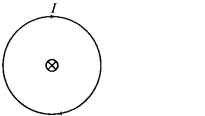
As, the wire is bent round in the form of a coil having N
turns.
∴ N × circumference of the coil = Length of the wire
⇒ N × (2πr) =
L
⇒ r = \(\frac{L}{2 \pi N}\) …(i)
Magnetic field at the centre of coil
due to N turns of a coil is given by
B = \(\frac{\mu_0(N I)}{2 r}\) =
\(\frac{\mu_0(N I)}{2\left(\frac{L}{2 \pi N}\right)}\) [from Eq. (i)]
=
\(\frac{\mu_0 \pi N^2 I}{L}\)
The direction of magnetic field is
perpendicular to the plane of loop and entering into it.
Question 27.
(i) Name the electromagnetic waves which
(a) maintain the
earth’s warmth and
(b) are used in aircraft navigation [2]
(ii) To which
part of the electromagnetic spectrum, does a wave of frequency 5 ×
1019 Hz belong? [1]
Answer:
(i) (a) Infrared rays
(b)
Microwaves
(ii) A wave of frequency 5 × 1019 Hz belongs to y-rays of electromagnetic spectrum.
Question 28.
State Lenz’s law. A metallic rod held horizontally along
east-west direction is allowed to fall under gravity. Will there be an emf
induced at its ends? Justify your answer. [3]
Or
A rectangular loop of
length l and breadth b is placed at distance of x from infinitely long wire
carrying current i such that the direction of current is parallel to breadth. If
the loop moves away from the current wire in a direction perpendicular to it
with a velocity v, what will be the magnitude of emf in the loop? [3]
Answer:
Lenz’s law states that the polarity of induced emf is such that it
tends to produce a current which opposes the change in magnetic flux that
produced it.
Yes, emf will be induced in the rod as there is change in
magnetic flux.
Or
Since loop is moving away from the wire, so the direction of current in the
loop will be as shown in the figure.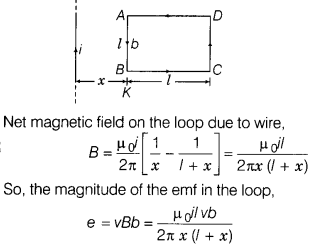
Section
D
[Case-Study Based
Questions]
Question 29.
Read the following paragraph and answer the questions that
follow
Mirror formula is a relation between focal length of the mirror and
distances of object and image from the mirror. When two rays originating from a
point on an object, trace their paths, find their point of intersection and
obtain image of the point due to reflection at a spherical mirror.
(i) Relation between u, v and R, if focal length of the mirror
\(\frac{R}{2}\) is
(a) \(\frac{1}{u}\) + \(\frac{1}{v}\) =
\(\frac{1}{R}\)
(b) \(\frac{1}{u}\) + \(\frac{1}{v}\) = \(\frac{2}{R}\)
(c) \(\frac{1}{u}\) + \(\frac{1}{v}\) = \(\frac{1}{f}\)
(d) None of these
Answer:
(b) \(\frac{1}{u}\) + \(\frac{1}{v}\) = \(\frac{2}{R}\)
Given, f = \(\frac{R}{2}\)
By using mirror formula,
\(\frac{1}{f}\) =
\(\frac{1}{v}\) + \(\frac{1}{u}\)
⇒ \(\frac{1}{R/2}\) = \(\frac{1}{v}\) +
\(\frac{1}{u}\)
⇒ \(\frac{2}{R}\) = \(\frac{1}{v}\) + \(\frac{1}{u}\)
(ii) A object is placed at a distance of 20 cm from the pole of concave
mirror of focal length 10 cm. The position of image will be [1]
(a) 10 cm
(b) -10 cm
(c) 20 cm
(d) – 20 cm
Answer:
(d) – 20 cm
Given, u = -20 cm, f = – 10 cm
Using mirror formula, \(\frac{1}{v}\) +
\(\frac{1}{u}\) = \(\frac{1}{f}\)
⇒ \(\frac{1}{v}\) = \(\frac{1}{f}\) –
\(\frac{1}{f}\)
⇒ \(\frac{1}{v}\) = \(\frac{1}{-10}\) – \(\frac{1}{-20}\) =
\(-\frac{1}{20}\)
⇒ v = -20 cm
(iii) In reflection over spherical mirror, ray parallel to principal axis,
after reflection from mirror pass through [1]
(a) focus
(b) centre of
curvature
(c) pole of mirror
(d) any point
Answer:
(a) focus
Or
A mirror is turned through 15°, with what angle will the reflected ray turn?
[1]
(a) 30°
(b) 90°
(c) 45°
(d) 65°
Answer:
(a) 30°
Given, θ = 15° and 2θ will be
2θ = 2 × 15° = 30°
(iv) If lower half of a concave mirror is blackened, then [1]
(a) image
distance increases
(b) image distance decreases
(c) image intensity
increases
(d) image intensity decreases
Answer:
(d) image intensity
decreases
If lower half of a concave mirror is blackened, then image will be now only half of the object, but taking the laws of reflection to be true for all points of the remaining part of the mirror, the image will be that of the whole object. However, as the area of the reflecting surface has been reduced, the intensity of the image will be reduced.
Question 30.
Read the following paragraph and answer the questions that
follows.
Semiconductor Diode
A semiconductor diode is basically a p-n
junction with metallic contacts provided at the ends for the various
application. It is two terminal device. When an external voltage is applied
across a semiconductor dipde, such that p-side is connected to th’e positive
terminal of the battery and n-side of the negative terminal, it is said to be
forward biased. An ideal diode is one whose resistance in forward biasing is
zero and the resistance is infinite in reverse biasing. When the biasing voltage
is more than the knee voltage, the potential barrier is overcome and the current
increases rapidly with increase in forward voltage.
When the diode is reverse
biased, the reverse bias voltage produce a very small current about a few
microamperes which almost remains constant with bias. This small current is
called reverse saturation current.
(i) Electric conduction in a semiconductor takes place due to [1]
(a)
electron only
(b) hole only
(c) both electrons and holes
(d) Neither
electrons nor hole
Answer:
(c) both electrons and holes
Electric conduction in a semiconductor occurs due to both electrons and holes.
(ii) The drift current in p-n junction is from the [1]
(a) n-side to the
p-side
(b) p-side to the n-side
(c) n-side to the p-side, if the junction
is forward biased and in opposite direction if it is reverse biased
(d)
p-side to the n-side if the junction is forward biased and in opposite direction
if it is reverse biased
Answer:
(a) n-side to the p-side
Drift current in p-n junction is from n-side to p-side.
(iii) Diffusion current in a p-n junction is greater than the drift current
in magnitude [1]
(a) if the junction is forward biased
(b) if the junction
is reverse biased
(c) if the junction is unbiased
(d) in no case
Answer:
(a) if the junction is forward biased
If the junction is forward biased, diffusion current is greater than drift current in terms of magnitude.
(iv) Forward biasing is that in which applied voltage [1]
(a) increase
potential barrier
(b) cancels the potential barrier
(c) is equal to 1.5
V
(d) None of the above
Answer:
(b) cancels the potential barrier
Forward bias opposes the potential barrier and if the applied voltage is more than knee voltage, it cancels the potential barrier.
Or
In V-I characteristic of a p-n junction, reverse biasing results in [1]
(a) leakage current
(b) the current barrier across junction increases
(c)
no flow of current
(d) large current
Answer:
(a) leakage current
Leakage current is the name given to the reverse current.
Section E
Question 31.
(i) You are given three lenses L1, L2
and L3 each of focal length 10 cm. An object is kept at 15 cm in
front of Lj as shown in figure. The final real image is formed at the focus of
L3. Find the separation between L1, L2 and
L3. [2]
(ii) Does the apparent depth of a tank of water change, if
viewed obliquely? If so does, the apparent depth increase or decrease? [2]
(iii) The radii of curvature of the faces of a double convex lens are 10 cm and
15 cm. If the focal length of the lens is 12 cm, find the refractive index of
the material of the lens. [1]
Answer:
For lens L1,
\(\frac{1}{f}\) = \(\frac{1}{v}\) – \(\frac{1}{u}\)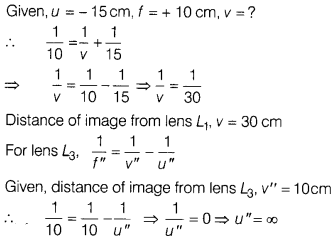
The refracted rays from lens L2 becomes parallel
to principal axis. It is possible only when image formed by L1 lies
at first focus of L2, i.e. at a distance of 10 cm from
L2.
∴ Separation between L1 and L2 = 30 +10
= 40 cm
The distance between L2 and L3 may take any
value.
(ii) Yes, the apparent depth decreases, further when water tank is viewed
obliquely as compared to the depth when seen normally.
(iii) Given,
R1 = +10
R2 = – 15 cm
f = +12 cm
μ =
?
Applying lens Maker’s formula,
\(\frac{1}{f}\) = (μ – 1)
(\(\frac{1}{R_1}\) – \(\frac{1}{R_2}\))
\(\frac{1}{12}\) = (μ – 1)
(\(\frac{1}{10}\) + \(\frac{1}{15}\))
\(\frac{1}{12}\) = (μ – 1)
(\(\frac{5}{30}\))
μ = \(\frac{3}{2}\)
Or
(i) Define a wavefront using Huygens’ principle. Verify the law of reflection
at a plane surface. [3]
(ii) Two slits are made 1 mm apart and the screen is
placed 1 m away. What is the fringe separation, when blue -green light of
wavelength 500 nm is used? [2]
Answer:
(i) A wavefront is the locus of all
points in the field of an optical disturbance having same phase at a given
instant.
Let 1,2, 3 be the incident rays and 1′, 2′, 3′ be the corresponding
reflected rays.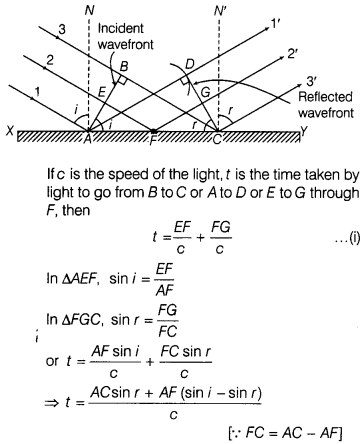
For rays of light from different parts on the incident
wavefront, the values of AF are different. But light from different points of
the incident wavefront should take the same time to reach the corresponding
points on the reflected wavefront.
So, t should not depend upon AF. This is
possible only, if
sin i – sin r = 0
i.e. sin i = sin r
or ∠i = ∠r
……(ii)
which is the first law of reflection.
Further, the incident
wavefront AS, the reflecting surface XY and the reflected wavefront CD are all
perpendicular to the plane of the paper.
Therefore, incident ray, normal to
the mirror XY and reflected ray all lie in the plane of the paper. This proves
the second law of reflection.
(ii) Here, d = 1 mm = 1 × 10-3 m, D = 1 m
λ = 500 nm = 500 ×
10-9 m = 5 × 10-7 m
Fringe width, ß = \(\frac{D
\lambda}{d}\)
ß = \(\frac{1 \times 5 \times 10^{-7}}{1 \times 10^{-3}}\)
ß
= 5 x 10× 10-4 m
ß = 0.5 mm
Question 32.
A series L-C-R circuit with L = 0.12 H, C = 480 nF, R = 23 Ω
is connected to a 230 V variable frequency supply.
(i) What is the source
frequency for which current amplitude is maximum? Obtain this maximum value.
[2]
(ii) What is the source frequency for which average power absorbed by the
circuit is maximum? Obtain the value of maximum power. [2]
(iii) For which
frequency of the source is the power transferred to the circuit half the power
at resonance?
What is the current amplitude at these frequencies? [1]
Answer:
Given, L = 0.12 H, C = 480 nF = 480 × 10-9 F,
R = 23 Ω
and Vrms = 230 V
⇒ V0 = 230√2 V
(i)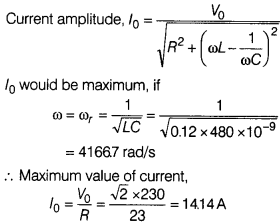
(ii) Average power absorbed by the circuit is maximum, if I = I0
at ω = ωr
Source frequency, vr = \(\frac{\omega_r}{2
\pi}\) = \(\frac{41667}{2 \pi}\)
= 663.48 Hz
Pav =
\(\frac{1}{2} I_0^2 R\) = \(\frac{1}{2}\)(14.14)2 × 23
= 2299.3 W
≈ 2300 W
(iii) Power transferred to circuit is half the power at resonant frequency,
then
∆ω = \(\frac{R}{2 L}\) = \(\frac{23}{2 \times 0.12}\) = 95.83
rad/s
∆v = \(\frac{\Delta \omega}{2 \pi}\) = \(\frac{95.83}{2 \pi}\) = 15.2
Hz
∴ Frequency when power transferred is half
= vr + ∆v =
663.48 ± 15.2
= 678.68 Hz and 648.28 Hz
∴ Current amplitude at these
frequencies
\(\frac{I_0}{\sqrt{2}}\) = \(\frac{14.14}{1.414}\) = 10 A
Q =
\(\frac{\omega_r L}{R}\) = \(\frac{4166.7 \times 0.12}{23}\) = 21.74
Or
Study the circuits (a) and (b) shown in the figure and answer the following
questions.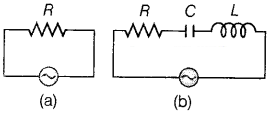
(i) Under which conditions would the rms currents in the two
circuits be the same? [3]
(ii) Can the rms current in circuit (b) be larger
than that in (a)? [2]
Answer: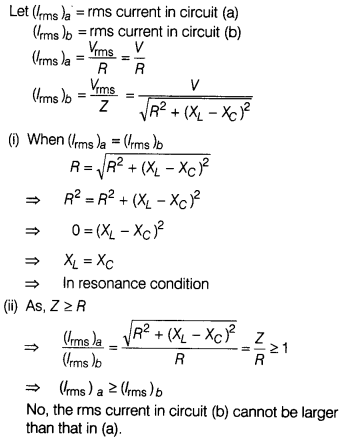
Question 33.
(i) If two similar large plates, each of area A having
surface charge densities +σ and -σ are separated by a distance d in air, find
the expression for
(a) field at points between the two plates and on outer
side of the plates. Specify the direction of the field in each case. [1]
(b)
the potential difference between the plates. [1]
(c) the capacitance of the
capacitor so formed. [1]
(ii) Two metallic spheres of radii R and 2R are
charged, so that both of these have same surface charge density a. If they are
connected to each other with a conducting wire, in which direction will the
charge flow and why? [2]
Answer:
(i) According to the question,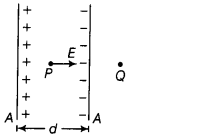
(a) Electric field due to a plate of positive charge
at
point, P = \(\frac{\sigma}{2 \varepsilon_0}\)
Electric field due to other
plate = \(\frac{\sigma}{2 \varepsilon_0}\)
Since, they have same direction,
so
Enet = \(\frac{\sigma}{2 \varepsilon_0}\) + \(\frac{\sigma}{2
\varepsilon_0}\) = \(\frac{\sigma}{\varepsilon_0}\)
Outside the plate,
electric field will be zero because of opposite direction.
(b) Potential difference between the plates is given by
V = Ed =
\(\frac{\sigma d}{\varepsilon_0}\) [∵ E = \(\frac{\sigma}{\varepsilon_0}\)]
(c) Capacitance of the capacitor is given by
C = \(\frac{Q}{V}\) =
\(\frac{\sigma A}{\sigma d} \varepsilon_0\) = \(\frac{\varepsilon_0 A}{d}\)
(ii) According to the question,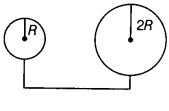
Potential at the surface of radius R,
V = \(\frac{k
q}{R}\)
= \(\frac{k \sigma 4 \pi R^2}{R}\) = σk 4πR = 4kσπR
Potential at
the surface of radius 2R,
V’ = \(\frac{k q}{2 R}\) [∵ q = σ × 4π(2R)² =
16σπR²]
So, V’ = \(\frac{k \sigma 16 \pi R^2}{2 R}\) = 8kσπR.
Since, the
potential of bigger sphere is more. So, charge will flow from sphere of radius
2R to sphere of radius R.
Or
A cube of side b has a charge q at each of its vertices. Determine the
potential and electric field due to this charge array at the centre of the cube.
[5]
Answer:
Consider a cube of side b and its centre be 0. The charge q is
placed at each of the corners.
Side of the cube = b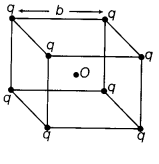
Length of the main diagonal of the cube
=
\(\sqrt{b^2+b^2+b^2}\) = \(\sqrt{3} b\)
Distance of centre O from each of the
vertices,
r = \(\)
Potential at point O due to one charge,
V =
\(\frac{1}{4 \pi \varepsilon_0}\) ⋅ \(\frac{q}{r}\)
Potential at point 0 due
to all charges placed at the vertices of the cube,
V’ = 8V = \(\frac{8 \times
1 \times q}{4 \pi \varepsilon_0 r}\) = \(\frac{8 q \times 2}{4 \pi \varepsilon_0
\cdot b \sqrt{3}}\)
= \(\frac{4 q}{\sqrt{3} \pi \varepsilon_0 b}\)
The
electric field due to one vertex is balanced by the electric field due to the
opposite vertex because all charges are positive in nature. Thus, the resultant
electric field at the centre 0 of the cube is zero.